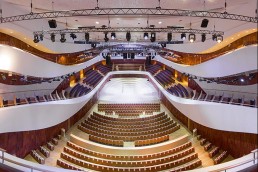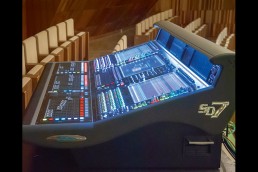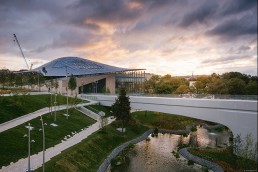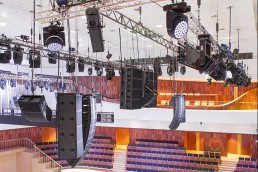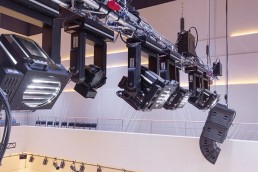This website uses cookies so that we can provide you with the best user experience possible. Cookie information is stored in your browser and performs functions such as recognising you when you return to our website and helping our team to understand which sections of the website you find most interesting and useful.
Zaryadye Concert Hall
ProjectZaryadye Concert HallLocationMoscow, RussiaManufacturers DiGiCo, L-Acoustics, Clay Paky, Robert Juliat, SpotlightDistributorSonoruss, ARISInstallerDOKA-CenterAcousticianYasuhisa ToyotaSubmitted by DiGiCo
Zaryadye is the flagship park in Moscow, Russia designed to set the standard for the country for public and green spaces. Back in 2012, Vladimir Putin proposed the construction of the park and today it is home to more than 10 hectares of attractions, which are expected to welcome more than 10 million visitors per year.
Upon entering the park at the Vasilevskiy spusk entrance, guests are greeted by the Dome – the information pavilion – and the first structure within the park to be completed. The Media Center is the main pavilion and spans 8,500 sq metres, while the second largest is the Nature Center, which is significantly smaller at just 3,300 sq metres. Both feature a number of exhibition spaces, as well as standard facilities such as cafés and souvenir shops. The River Outlook – a viewing point above the river – is a popular attraction in the park as it takes in panoramic views on the Kremlin, the embankment of the Moskva River and the park itself.
The Large Amphitheatre, the Zaryadye Gastronomic Center and the Voskhod restaurant also lie in the grounds of the park, as does The Glass Crust – an artificial hill that hides the Concert Hall. And it is within the Concert Hall that a plethora of new technology has been installed to offers visitors the best possible audiovisual experience.
The concert complex consists of two halls, the Grand Hall with 1,600 seats and the Small Hall with a capacity of 400. Zaryadye Grand Hall is a unique hall for Russia in terms of integrated stage mechanisation, modern engineering solutions and technologies. The physical transformation of its space allows it to be able to hold different events, for example, the tiered stalls can be put to the same level as the parquet, the orchestra pit can be covered to extend the parquet square, and the choir pit can be put on different heights or levelled with the stage.
The Small Hall usually hosts educational programmes, chamber symphony concerts, and experimental theatrical projects using electro acoustics.
Famous Japanese acoustic engineer, Yasuhisa Toyota, Head of Nagata Acoustics, created the acoustic design of the concert complex. He has built more than 50 theatres and concert halls around the world, so was well placed to take on this project. The first acoustic test of the Grand Hall took place in March 2017. For testing the reverberation time, an exact replica of the hall was built in a 1:10 scale, but instead of the audience in the chairs there were mannequins with the built-in microphones. The test period took nearly six months, and only then was the concept and design confirmed and the acoustic decoration of the hall could begin to take shape under the specialist supervision. The walls and the ceiling of the halls are decorated with acoustic panels using solid mahogany wood. The stage floors are made of special cedar wood providing excellent acoustic parameters and reverberation time. The audience floor in both halls are laid out with oak parquet board.
When it came to selecting the audio set-up for the new concert hall, the in-house technician team used more than one supplier. Firstly, it contacted ARIS to provide the mixing system. The main requirement was to meet the riders of international artists. As the Grand Hall is a transformer hall with state-of-the-art stage mechanics that can turn the tiered auditorium into a flat surface in just 40 minutes, the mixing system needed to be flexible to cater for different performance types. The different staged presentation platforms allow the hall to host classical symphony concerts, jazz, opera and pop shows, forums, international conferences, festivals, contests, balls, and more with the help of these mechanics, which were developed by French company, Serapid. The concert hall is the first place in the world to use such a system.
The technical team at Zaryadye was already familiar with ARIS, as well as DiGiCo mixing consoles, having worked together previously at Moscow International House of Music, so the choice to use DiGiCo and ARIS was an obvious one. An SD7 B for FOH and an SD10 for monitors running on Optocore and Waves were selected and installed at the concert hall.
The second company to get involved with the audio set-up was L-Acoustics, which worked with its certified provider distributor for Russia, Sonoruss, as well as DOKA-Center – the general contractor of Zaryadye – and Modern Sound Technologies. A close cooperation of the acoustics engineers from the companies allowed them to surpass the questions and complexities of the architectural and acoustic design successfully.
The acoustic calculations were carried out in L-Acoustics’ predication software, Soundvision. This allowed the complex system to be designed within the acoustic parameters, and enabled the numerous changes and amendments to the general technical design specification of the hall to be incorporated along the way with minimal disruption. The final installed system does have a reverberation time of about three seconds though – according to the acoustic engineers from Sonoruss – which makes it difficult to host popular music concerts in Zaryadye.
The main FOH system of the Grand Hall consists of 11 L-Acoustics KARAi per side supplemented by SB18i and SB28 subwoofers, that can be mechanically lifted to the ceiling void to comply with the requirements of the philharmonic events, clearing the sight of the acoustic reflectors in the hall for acoustic instruments.
An additional set of KARA, SB18 and X8 loudspeakers are used as front-fill and in-fill systems to provide sound for the front rows of the parquet, the orchestra pit, and larger or smaller stage configurations depending on whether it is set up as a tiered theatre or a flat floor stage. The front-fill KARA systems in addition to their main task can be also used as side-fill or drum-fills. The inventory also includes ARCS Focus, ARCS Wide, and X12’s that can be utiliised in the balconies for different hall transformations.
The floor monitor lines consist of both 108P and 112P active systems, and passive X15 HiQ systems powered by respective controller-amplifiers. With such a broad-range of equipment, the complete system is totally multifunctional and universal, which provides a solution for almost any type of concert or function.
The DOKA-Center team specified a combination of traditional theatrical fixtures – fresnels, followspots and luminaires – from Robert Juliat and Spotlight, as well as intelligent lighting fixtures from Clay Paky.
In total, over 100 Robert Juliat luminaires were supplied, including 29 RJ 325LF Cin’k and 20 RJ 326LFV Cin’k fresnel tungsten fixtures, 20 RJ 710 SX2 and 12 RJ 711 SX2 profile tungsten lanterns, 24 RJ D’Artagnan 930SNX 2500W discharge profile lanterns, and four RJ Victor 1,800W HMI followspots with DMX control.
The RJ 325LF Cin’k fresnels were fitted with 2.5kW tungsten lamps and the RJ 326LF Cin’k fresnels with 2,500W discharge lamps before all were mounted in motorised yokes and rigged in the overhead grid. From here the fresnels are used to deliver soft edged, bright beams of light to the orchestra pit and the stage, largely due to the 250mm fresnel lens present in both types of fixture.
The Robert Juliat fixtures are installed in both the Grand Hall and the Small Hall, with the four Victor followspots installed permanently in both venues. The 10°-25° zoom range of the RJ 710 profile and the 8-16° zoom range of the RJ 711 profile with its extremely narrow beam are very useful for the multiple uses to which they are put. “The profiles are used as side light, as front light from stationary soffit bridges and as conductor lighting,” said Vasily. “Each lighting designer has his own preferences for where the equipment should be installed so the RJ’s versatility is a huge asset.”
For the 79 motorised yokes mounted onto the RJ fixtures and others, DOKA-Center chose the ARC STAGE arms, made by Italian-based SPOTLIGHT. The full installation of the DMX controlled yokes relies on 49 ARC STAGE/3 for tilt, pan and focus of the frensel and 30 ARC STAGE/2 for which only tilt and pan
were needed. Additionally, for the Small Hall, 30 of SPOTLIGHT’s pole operated yokes for tilt, pan and focus (PO/3) have been used for easy positioning and focusing at accessible heights.
SPOTLIGHT added LED Tunable light power to the line-up with a total of 30 FN LED 450 TW DMX fresnels and 20 PR LED 450 ZS TW DMX profiles for the Grand Hall, both of which have light outputs equivalent to one of a 2,000-2,500W halogen lamp but with a life of 30,000 hours and the use of only of 450W, making both of model environmental friendly and low maintenance.
Furthermore, in the Small Hall SPOTLIGHT supplied 44 FN LED 150 TW DMX fresnels, a new fixture in the range that is capable of generating white light in different colour temperature, from 3,000K to 6,500K. These sit alongside eight CYC 300 RGBW DMX floodlights, another new product, which features a sophisticated specifically designed optical system, allowing even illumination of an area measuring approximately six-metres wide and seven-metres high when positioned at just 1.5-metres from a backdrop.
From Clay Paky, DOKA-Center supplied 54 A.LEDA B-EYE K20 LEDs, 12 Scenius Spots, 12 Scenius Profiles and 30 Show Batten 100 LEDs.
Furthermore, DOKA-Center along with Stroyscirc selected 24 Movecat chain hoists with 500kg load capacity and 20 chain hoists with 1,000kg load capacity to be integrated into the existing in-house control system at Zaryadye. The new hoists are equipped with absolute value encoders and load measuring cells and comply with DGUV V17 (formerly BGV-C1).
